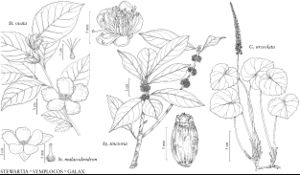Difference between revisions of "Symplocaceae"
FNA>Volume Importer |
imported>Volume Importer |
||
| Line 61: | Line 61: | ||
|publication year= | |publication year= | ||
|special status= | |special status= | ||
| − | |source xml=https:// | + | |source xml=https://bibilujan@bitbucket.org/aafc-mbb/fna-data-curation.git/src/bb6b7e3a7de7d3b7888a1ad48c7fd8f5c722d8d6/coarse_grained_fna_xml/V8/V8_652.xml |
}}<!-- | }}<!-- | ||
-->[[Category:Treatment]] | -->[[Category:Treatment]] | ||
Revision as of 00:13, 28 May 2020
Shrubs or trees, deciduous [evergreen], often accumulating aluminum, tanniferous. Leaves alternate, spirally [distichously] arranged, simple; stipules absent; petiole present; blade margins serrate, serrulate, dentate, or crenulate-serrulate, sometimes nearly entire. Inflorescences usually axillary, rarely internodal, panicles or fascicles [racemes, spikes, or solitary flowers]. Flowers bisexual [unisexual]; perianth and androecium epigynous; hypanthium adnate to ovary wall; sepals [3–]5, connate proximally; petals [3–]5[–11], connate proximally [to middle]; nectary disc present; stamens ca. 40–100 [rarely ca. 5–15 in dioecious species], adnate to corolla at base [to middle], 1–4-seriate, in antisepalous fascicles [± evenly distributed]; anthers dehiscent by longitudinal slits; pistils 1, 2–3-carpellate; ovary inferior [subinferior], incompletely 2- or 3[–5]-locular; placentation mostly axile (intruded); ovules anatropous, unitegmic, tenuinucellate; styles 1, hollow, filiform [subulate]; stigmas 1, 2–5-lobed [capitate]. Fruits drupaceous. Seeds 1[–5], brown, ovoid or reniform, [ellipsoid, ampulliform, U-shaped, or S-shaped]; embryo straight [curved]; endosperm copious, oily.
Distribution
se United States, West Indies (Antilles), South America (Argentina, Brazil), Asia (China, India, Japan), Pacific Islands (Fiji), Australia, temperate, tropical, and subtropical areas.
Discussion
Genera 2, species 320 (1 genus, 2 species in the flora).
Cordyloblaste Henschel ex Moritzi, with two species, occurs in eastern Asia (P. W. Fritsch et al. 2008).
Following A. L. de Jussieu (1789), some authors have long placed the Symplocaceae in Ebenales close to Styracaceae; others have placed it in Theales or Cornales (B. Ståhl 2004b). The recent ordinal classifications of the Angiosperm Phylogeny Group (1998, 2003) assigned it to the more broadly circumscribed Ericales (including Ebenales), comprising 24 families. Studies with DNA sequence data place Symplocaceae as sister to Styracaceae + Diapensiaceae (J. Schönenberger et al. 2005).
Within Ericales, Symplocaceae are distinguished by their estipulate leaves; sympetalous, actinomorphic corollas; epipetalous, connate stamens; inferior ovaries; simple styles; unitegmic ovules; and drupaceous fruits. These features and recent phylogenetic studies based on DNA sequence data and morphology leave no doubt that Symplocaceae constitute a monophyletic group (Wang Y. et al. 2004; P. W. Fritsch et al. 2006, 2008).
